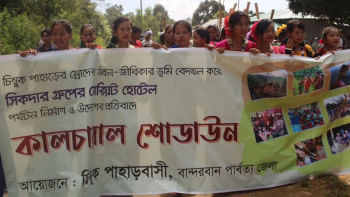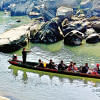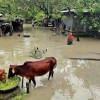What message does the Bandarban flood give us?

During the monsoon season in Bangladesh, floods are a usual occurrence in the low-lying areas of northern and northeastern parts of the country. But this year, we witnessed something unusual: the highest parts of the country got inundated during heavy rains. It was so bad that communication among Bandarban's Ruma, Thanchi, Alikadam, Rowangchhari upazilas was snapped, and the Chattogram-Cox's Bazar highway was submerged. In Bandarban, high-rise buildings got flooded, landslides destroyed jhum fields, and mountain runoff ruined croplands on the banks of rivers and streams.

The Bandarban town is surrounded by mountains; when it rains during monsoon, the rainwater flows through the town via streams into the Sangu River. This year, however, the streams could not hold the excess rainwater from days of heavy downpour, which is why the town was flooded.
But why couldn't the streams hold the excess rainwater like before?
Much like Dhaka, Bandarban's development has also been unplanned and not aligned with the local ecosystem. Unplanned infrastructural development has taken place by changing the ecological balance of soil and by cutting hills indiscriminately. Many streams and drains have gotten blocked as a result, which means the natural water flow out of the town is obstructed. The cruel practice of neoliberal profit-driven development is what has caused the flood in Bandarban.
This year's flood and prolonged waterlogging was the worst case of such natural calamity that Bandarban has seen in years. At least 14 people were reportedly killed by landslides and drowning, as of August 9. The amount of loss in terms of livestock and wildlife deaths is anyone's guess. Media coverage of the flood was less than adequate as power and internet connections in Bandarban were disrupted; the plight of Bandarban's people did not get as much attention as those in Sylhet-Sunamganj areas.
It is important to understand the cautionary message that the Bandarban flood sends out. Discussions on this issue require looking into the region's ecosystem, local knowledge of and practices to mitigate natural disasters, and the environmental issues. If the conflict between the local ecology and developmental politics is not resolved, crises like this will intensify in the future.

Tuikling mangmo and the fear of 'Rina'
The Hangor Canal, which the local Mro community calls Hank-O, flows through Tongkaboty union in Bandarban Sadar upazila, into the Tongkaboty Canal. On the slopes of its banks, local Indigenous communities grow paddy and seasonal vegetables. During the spell of heavy rain in early August, the overflow of water from the canal flooded the crop beds, destroying the harvest. Croplands in the plainland got washed away too. Landslides caused by constant rain destroyed jhum croplands on the hills. Several hilly villages suffered extensive damage. Local Mros said this crisis surpassed even the suffering during the height of Covid pandemic. This was the worst ecological crisis in the hills since the 2007 "rat flood" (Kaoingkyang/Kaopaokong in Mro language), which had created a severe food shortage.
In the Mro language, seasonal floods are called tuilot. When streams, canals and rivers swell up during monsoon rains and overflow their banks, flooding the surrounding areas, it is called tuilot. But this year's flood was not tuilot; to the Mros, it was tuikling mangmo – the kind of flood that causes lasting damage to the environment and community. Floods like tuikling mangmo causes tuitunung, or waterlogging. Mro elders in Bandarban consider the recent flood to be the result of aggressive development in the region. According to them, since forests on the hills have been cleared off to make space for development, there is no protection against runoffs caused by excessive rain. Hilly streams, canals and rivers have been encroached; commercial extraction of stones from the streams and rivers has destroyed their capacity to hold water. Indiscriminate hill-cutting has led to increased landslides. Some vested groups are adamant to put a stop to the environment-friendly practice of jhum cultivation on the hills. The number of invasive tree gardens and commercial fruit orchards is rising, further leading to soil erosion and landslides. Many streams have been lost to long spells of drought and soil deposits. Unplanned construction of infrastructures and dumping of plastic waste from corporate tourism have clogged many waterways. That is why now heavy rains lead to waterlogging in the hilly areas.
Local Mros never extract stones from the hilly streams and rivers. They believe these stones are the spiritual guards of these water bodies, and extracting them would anger a god named Kuimia. They fear they will be cursed with a disaster like "Rina" – Mro for epidemic.
Corporate consumerism, corruption, dangerous waste – we took them all to the hills. But we never tried to learn the local philosophy and practice of ecology and diversity. Streams, falls, rivers are being killed due to rampant stone extraction. And because of that, these rivers and streams are getting filled up with soil and sediment deposits. The devastating flood right when the local communities started recovering from the effects of the pandemic has dragged them back to square one.

Hills disappearing
Bandarban is home to a number of hills in the country. Numerous streams and falls in the region have originated from these hills. Rampant hill-cutting has disrupted the natural flow of these water bodies, not to mention it raised the frequency of landslides. It is somewhat evident that it is not the local communities, but the Bangalees coming from outside the region, driven by their greed for profits and power, who are mainly involved in hill-cutting. Any hill that has a slope of more than 45 degrees is at risk of landslides. In the Chittagong Hill Tract area as well as in Cox's Bazar, some hills have been cut so steeply that they have a 90-degree slope.
Ecosystem at the hills is in a fragile state. Understanding and learning the Indigenous knowledge of the environment is of utmost importance to protect the hills. To stop hill-cutting and landslides, local environmental knowledge must be incorporated into the country's development plan.

Don't let Bandarban become another Kaptai
In the 60s, hundreds of thousands of people lost their homes due to the Kaptai hydroelectric plant project in Rangamati. That terrible loss left a permanent scar on the collective memory of the Chakma community there. This year's Bandarban flood brought back that painful memory for many. This year's flood has reminded us once again that our development journey in the hills is not aligned with the local ecosystem and cultural diversity. Development activities in the hill areas must be designed in a way that they don't disrupt or harm the natural and cultural diversity. To achieve that, we must learn and adopt local knowledge of the hills' environment, ecosystem, resilient practices, and philosophy. Or else, Bandarban will keep disappearing under floodwater.
Translated from Bangla by Sumaiya Binte Shams.
Pavel Partha, an ecology and biodiversity conservation researcher, is director at Bangladesh Resource Centre for Indigenous Knowledge (BARCIK).He can be reached at [email protected].
Views in this article are the author's own.
Follow The Daily Star Opinion on Facebook for the latest opinions, commentaries and analyses by experts and professionals. To contribute your article or letter to The Daily Star Opinion, see our guidelines for submission.

 For all latest news, follow The Daily Star's Google News channel.
For all latest news, follow The Daily Star's Google News channel. 










Comments